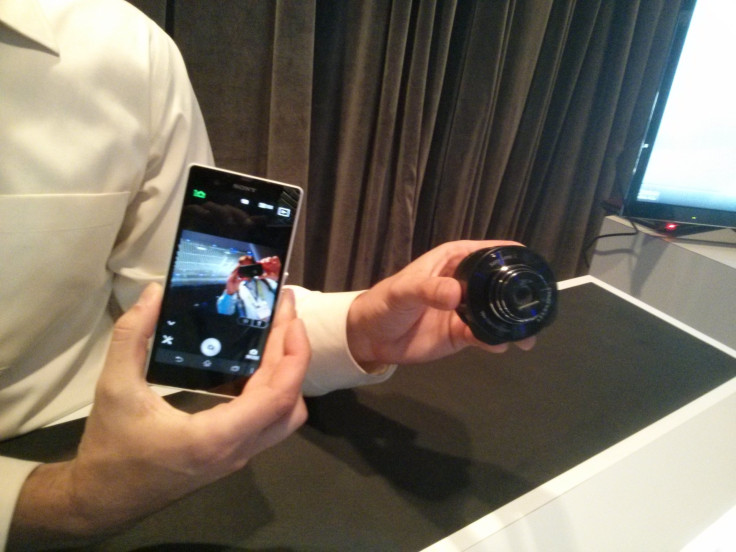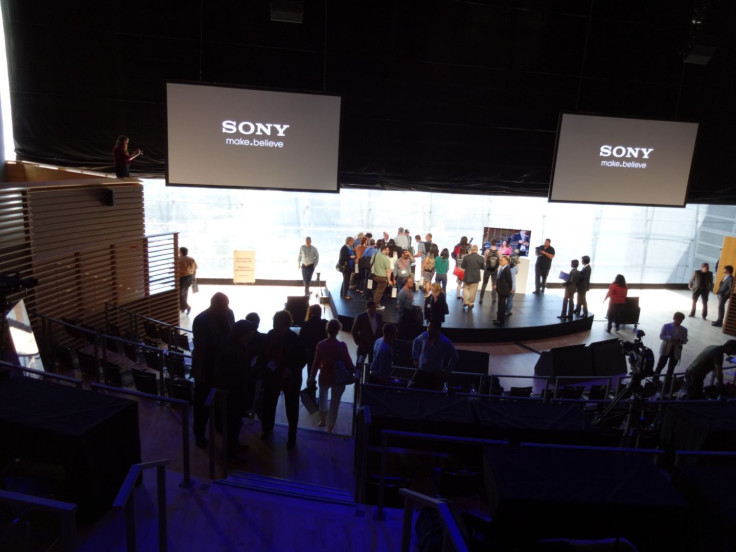Sony DSC-QX10 And QX100: Hands-On Review Of The Clip-On 'Lens' Cameras For iPhone, Android Smartphones [PHOTOS]
Manufacturers are racing to offer the very best smartphone camera – from the Nokia Lumia 1020’s 42-megapixel sensor, to the large lens on the Samsung Galaxy S4 Zoom. Sony (NYSE:SNE) will now offer one of the stranger smartphone accessories on the market – the DSC-QX10 and DSC-QX100 -- in an attempt to improve the mobile photography experience without forcing a gigantic lens into a smartphone.
The International Business Times was able to go hands-on with the DSC-QX10 and QX100 at a press event at the Jazz at Lincoln Center venue in New York City last week, where Sony Electronics U.S.A. unveiled several new products. While the products were still in an initial, pre-release state, we at IBTimes were able to get a feel for the QX10 and QX100 to form an initial impression of Sony’s lens-style cameras.

What is it like to use the QX10 and the QX100? There is certainly a bit of a learning curve to using the QX10 and QX100, and while the pre-release software on which they currently is imperfect, there is a lot to like about the mobile lens-style cameras.
The DX10 will retail for $249, offering 10x optical zoom and a back-illuminated, 18-megapixel sensor which offered excellent picture quality even in the dimly lit presentation hall. The DX100 has a 3.6x zoom and a more high-end sensor, and will retail for $499 when the devices go on sale on Sept. 25.
To use the DX10 and DX100, Android and iPhone users will have to download the Sony PlayMemories Mobile from their respective app stores, and pair the lens camera to the phone using NFC. The QX10 and QX100 have a physical shutter button (to take a shot) and zoom control built on the outside of their lens, and the PlayMemories Mobile app has touchscreen versions of the same.
The QX10 and QX100 both have a housing that allows them to clip on to any smartphone. They also can be detached and used separately – but the detaching process is not an easy one. The Sony representative who detached the frame struggled with it for a minute before she could hand over the lens.
The bottom line
The QX10 and QX100 are too big to fit in a pocket, that’s for sure. But if you care about the quality of photos you take, the QX10 and QX100 are a fantastic way to keep the smartphone of your choice without having to lug around a full-sized DSLR camera.
The PlayMemories Mobile software is not perfect. I was able to connect my LG Nexus 4 to take a few shots, but an attempt to take a series of quick shots simultaneously failed, and brought up an error message. However, by the time the QX10 and QX100 see a release later this month, here’s hoping that Sony improves the app. Because the QX10 and QX100 are versatile, compact, and take great photos.

The fact that the QX10 and QX100 can be used separately from a smartphone is interesting, but not extremely useful seeing as they lack an LCD screen or viewfinder. The real strength of the QX10 and QX100 is the accessory nature of the devices – you can use them with the smartphone of your choice, without having to pick your phone based on its camera and end up with something that looks like an ergonomic nightmare or be forced into the Windows Phone 8 ecosystem.

Based on a brief hands-on with the QX10, we found it to have better overall value. While it has a lower-end sensor, the 10x optical zoom is incredibly useful. While Nokia advertises the Lumia 1020’s 42-megapixel sensor as allowing users to “zoom” after taking the photo, optical zoom will always beat out cropping a high-resolution photo when it comes to clarity.
For $249, the QX10 is a well-priced and powerful smartphone accessory, and perhaps the first that consumers won’t have to toss in the trash when they get a new phone. The QX100, at $499, is priced too high for many consumers but a good choice for serious or professional photographers looking to lose some weight from their camera bag.
© Copyright IBTimes 2024. All rights reserved.





















